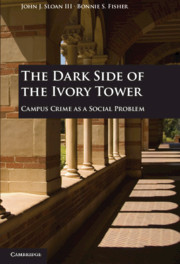Book contents
- Frontmatter
- Contents
- Preface
- Acknowledgments
- The Dark Side of The Ivory Tower
- Chapter One Violence, Vice, and Victimization on American College and University Campuses
- Chapter Two Constructing Campus Crime as a New Social Problem
- Chapter Three Constructing Unsafe and Violent College Campuses
- Chapter Four Constructing the Sexual Victimization of College Women on Campus
- Chapter Five Constructing Postsecondary Institutional Liability for Campus Crime
- Chapter Six Constructing Binge Drinking on College Campuses
- Chapter Seven The Legacy of Claimsmakers
- Index
- References
Chapter One - Violence, Vice, and Victimization on American College and University Campuses
A Brief History Lesson
Published online by Cambridge University Press: 05 June 2012
- Frontmatter
- Contents
- Preface
- Acknowledgments
- The Dark Side of The Ivory Tower
- Chapter One Violence, Vice, and Victimization on American College and University Campuses
- Chapter Two Constructing Campus Crime as a New Social Problem
- Chapter Three Constructing Unsafe and Violent College Campuses
- Chapter Four Constructing the Sexual Victimization of College Women on Campus
- Chapter Five Constructing Postsecondary Institutional Liability for Campus Crime
- Chapter Six Constructing Binge Drinking on College Campuses
- Chapter Seven The Legacy of Claimsmakers
- Index
- References
Summary
Despite…numerous warnings…[19th-century] college students continued to consume alcohol, play cards, bet on horse races, and pursue sexual liaisons. They also used violence to settle conflicts among themselves and to protest college discipline. College students’ persistent reputation for rowdiness and debauchery reflects the influence of the “code of honor” which allowed, and even encouraged, drunkenness, gambling, sexual license, and fighting.
Since the 1980s, a shift in thinking about college and university campuses has occurred in the United States. No longer is the “ivory tower” of academe perceived as a place of retreat for scholarly inquiry. Nor is college perceived as a time for growth, where students “find themselves” and their place in the world. Rather, when talk turns to life on college campuses, that talk is often about crime, especially violence. In particular, the recent mass shootings at Virginia Tech and Northern Illinois University are often used to illustrate just how dangerous college campuses have apparently become. Besides mass shootings occurring on campus, date rape, sexual assault, and other forms of violence against women seem commonplace. In fact, a recent report on the sexual victimization of college women published by the U.S. Department of Justice indicated that approximately 3 percent of college women experience either an attempted or a completed rape during a typical nine-month academic year. According to one New York Times story, violence has “become a way of life for college students,” and some researchers suggest that media reports on campus violence have “created the impression that college and university campuses are increasingly dangerous places.”
During the past 20 years, individuals and their families who have been affected by violence on campus have often responded to these events by successfully suing postsecondary institutions over these incidents. In their lawsuits, student victims or their families have claimed that colleges and universities were liable for damages arising from these incidents because campus security was lax at best and nonexistent at worst. The legal basis for victims’ claims was the argument that postsecondary institutions owed a legal duty of care to students and campus visitors to protect them from harm, especially when such harm was foreseeable.
- Type
- Chapter
- Information
- The Dark Side of the Ivory TowerCampus Crime as a Social Problem, pp. 1 - 28Publisher: Cambridge University PressPrint publication year: 2010

